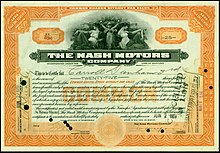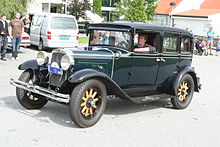Nash Motors
Nash Motors was an American automobile manufacturer in Kenosha , Wisconsin that existed from 1916 to 1938. From 1938 to 1954, Nash was the automotive division of the Nash-Kelvinator Corporation . The production of Nash automobiles continued from 1954 to 1957 after the founding of the American Motors Corporation .
history
Nash Motors was founded in 1916 by a former officer of General Motors , Charles W. Nash , founded the Thomas B. Jeffery Company bought. Jeffrey's most famous automobile was the Rambler . Nash successfully sold mid-range cars to middle-class buyers for decades .
Much of the company's early success was due to Charles Nash's loyalty to his chief engineer, Nils Erik Wahlberg . Wahlberg was an early fan of wind tunnel tests for vehicles. Wahlberg is also one of the designers of the car ventilation system, in which outside air is sucked in and heated at the front and then exits through the rear openings. This process also helped to reduce humidity and to even out the small pressure difference between the interior of a moving vehicle and the environment.
Nash's slogan in the 1920s and 1930s was "Give the customer more than he has paid for," and his cars lived up to that slogan. The innovations included an overhead in -line eight-cylinder engine, dual ignition and nine crankshaft bearings . The Ambassador Eight from 1932 had a fully synchronized gearbox and freewheel , automatic central lubrication and the wheel suspensions were adjustable from the inside.
The Ajax
For the 1925 model year, Nash introduced the entry-level brand Ajax . The car of excellent quality for its price was in the newly acquired factory Mitchell Motor Car Company in Racine , Wisconsin , built. Mitchell was the manufacturer of the automobiles of the same name from 1903 to 1923. However, sales of Ajax automobiles remained - although quite respectable - below expectations. So it was thought that this car would sell better if it bore the Nash name. In June 1926, the Ajax became the Nash Light Six and sales increased - as expected. Although unusual, Nash offered all Ajax buyers a package to convert their cars to the Nash Light Six. This free conversion kit included new axle caps, a radiator emblem, and all the other parts necessary to turn an Ajax into a Nash Light Six. The aim was to protect buyers from the inevitable loss of value when the Ajax brand was discontinued. This showed the high value Nash Motors attached to customer satisfaction. Most Ajax owners took advantage of this generous offer, and Ajax models that have not been converted are very rare today.
The acquisition of LaFayette
The LaFayette Motors Corporation hired a big, powerful and expensive luxury cars ago. The company began production in Indianapolis , Indiana in 1920 and later relocated to Milwaukee , Wisconsin . The main shareholder in LaFayette Motors was the Nash Motors Company. Other large blocks of shares were held by Charles Nash and his friends and business associates. The high quality, expensive LaFayette wagons did not sell well.
Nash Motors took over the company in 1924 and used the Milwaukee factory to manufacture Ajax automobiles. The LaFayette name was reintroduced in 1934 as Nash's entry-level brand. With the edition of the 1937 models, LaFayette disappeared as an independent brand. From 1937 to 1940, the Nash LaFayette was the cheapest Nash model. It was replaced in 1941 by the new Nash 600 with a monocoque body.
The era of George Mason and Nash-Kelvinator
When Charles Nash retired from his business, he appointed George W. Mason as his successor. Mason was the head of Kelvinator , the leading manufacturer of luxury refrigerators and kitchen equipment in the USA at the time, and accepted the offer, but made one condition: Nash should acquire a majority stake in Kelvinator. The factories combined from January 4, 1937 bore the name Nash-Kelvinator Corporation . The brand name Nash now referred to the automotive division of Nash-Kelvinator. This was the largest merger of companies from different industrial sectors in the USA to date.
In 1938, Nash offered an air conditioning and air heating system for his cars on request, a result of the cooperation between the two parts of the company. This was the first warm water heater for cars that drew in fresh air from the outside, and can therefore be considered the basis of all modern car heaters. Also in 1938, Nash, together with automakers Studebaker and Graham, offered a vacuum-operated transmission, an early attempt to ban the gear lever from the front footwell. Cars with the Automatic Vacuum Shift (from Evans Product Company) had a small preselection lever built into the dashboard, just below the radio control.
In 1936, Nash introduced the "Bed-In-A-Car" feature that turned the interior of the car into a bedroom. The backrest of the rear seat could be folded down and the height of the seat could be changed. This also created an opening between the passenger and trunk. Two adults could sleep in the car with their legs in the trunk and shoulders and heads on the back seat. In 1949, this facility was completed with the introduction of reclining seats, resulting in a continuous bed area in the interior. In 1950 the backrests of the front seats could be locked in different positions. Nash soon called these seats "Airliner Reclining Seats".
In 1939, Nash introduced a thermostat for the air conditioning and air heating system, and so the famous "Nash Weather Eye Heater" was born. The streamlined cars of 1939 and 1940 were drawn by George Walker and Associates and the freelance designer Don Mortrude . They came in three versions: LaFayette, Ambassador Six and Ambassador Eight .
The Nash 600 , introduced in 1941, was the first mass- produced monocoque body construction in the USA. Its lower weight in comparison with vehicles with a bolted frame, its lower air resistance and the overdrive transmission ensured a low fuel consumption for this time. The designation "600" is supposed to come from the fact that the car could cover 600 miles (961 km) with a 20-gallon tank (= approx. 90.6 liters). Between 1942 and 1948 the front, chrome trim and upholstery were revised several times.
The introduction of the Nash Airflyte
The 1949 streamlined Nash Airflyte was the company's first car to be introduced with a radically new design after World War II . Its aerodynamic body was developed in the wind tunnel. Nils Wahlberg's theories for reducing the drag coefficient of a car required a round body shape and integrated front fenders. Wide and low as it was, this model offered more interior space than its 1948 predecessor. Because of the integrated front fenders, the Nash automobiles had a larger turning circle than most other cars.
Nash-Kelvinator President George Mason thought Nash had greater market opportunities with smaller automobiles. So he led the company to develop the first compact car of the post-war era, the Rambler of 1950, which was offered as a well-equipped luxury convertible. Mason also arranged the introduction of the Austin- built Metropolitan from Great Britain , which was available from 1954.
The big Nash Airflytes were completely redesigned in 1952 and marketed as Golden Airflytes in commemoration of the company's 50th birthday as an automobile manufacturer. (This includes the years of the Thomas B. Jeffrey Company ). “Great Cars Since 1902” was the company's slogan. The new Golden Airflytes had a more modern, angular look than the models from 1949-1951, which were often compared to upturned bathtubs.
Mason also worked with British automobile enthusiast Donald Healey and brought out the Nash-Healey , the first American sports car since the Great Depression. Originally, both companies were supposed to manufacture the car. In the second year of production, however, the body was revised by the Italian designer Pininfarina , who then also supplied Healey with bodies. Nash sent the mechanics for the cars to Great Britain, where Donald Healey's company built them into their own chassis. The fully equipped chassis were then sent to Italy, where the bodies were put on. The finished cars were then shipped back to the US for sale. The resulting immense production costs and the concentration of Nash on the Rambler model led to the discontinuation of production in 1954 after only 506 copies. George Mason commissioned Pininfarina to design the Nash-Healey's successor, the Nash Palm Beach , but the project never got beyond the prototype stage. The 1953 starting list of Le Mans shows some Nash Healeys and a Nash Palm Beach - registered by Allard . The Nash-Healeys took first and second place in their group (Sports 3000 - the same as the Austin-Healeys ) and all vehicles were able to finish the 24-hour race. The interest this year was in the Jaguars (in the Sports 5000 group) and the Cunninghams (in the Sports 8000 group). The only Nash-Healey with a larger 5 ltr. - Machine able to compete with the Jaguars and Ferraris could not finish the race due to problems with the oil pressure.
American Motors Corporation founded
In January 1954, Nash announced the friendly takeover of Hudson Motor Car Co. , creating the American Motors Corporation (AMC). In order to improve the financial situation of the combined plants, the entire production of the 1955 models of Nash and Hudson was moved to the Nash plant in Kenosha. Nash mainly advertised its smaller Rambler models, while Hudson promoted the big cars.
In 1955, all large Nash and Hudson models were based on a common body structure, but had different mechanics and their own, non-interchangeable body parts, of the type that the Big Three (GM, Ford and Chrysler) practiced for many years in order to make production as economical as possible to reach.
The Metropolitan , which existed as Nash and Hudson, became its own brand in 1957, as did Rambler . Rambler even surpassed the Nash and Hudson brands within the AMC group.
Soon after the merger in 1954, CEO George Mason died. Mason's successor, George Romney , firmly linked the future of the company with an expanded range of Rambler models and slowly let the Nash and Hudson brand names die by the end of 1957. On June 25, 1957, production of the Nash and Hudson models ended. From 1958 to 1965, Rambler was AMC's only brand; only the Metropolitan remained in the car dealer's windows until 1962. Under the direction of Roy Abernethy , the Rambler name was also slowly abandoned, which began in 1965 and ended with the brand's discontinuation in 1969.
In 1970 American Motors Corporation bought Kaiser Jeep , a brand derived from Willys-Overland Motors , and its manufacturing facilities in Toledo , Ohio . In the early 1980s, AMC partnered with Renault who sought to re-enter the US market in the 1980s. Finally, in 1987, AMC was bought by Chrysler Corporation and became their Jeep Eagle division.
Timeline of the models
gallery
Web links
- Nash Car Club (English)
- The Nash-Healey story
- Nash in Scandinavia (English / Swedish / Finnish)
- Nash in GB (English)
literature
- Gunnell, John (editor), The Standard Catalog of American Cars 1946-1975 , Kraus Publications (1987), ISBN 0-87341-096-3




























